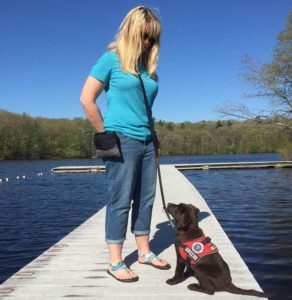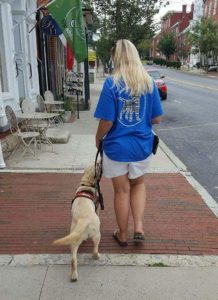By: Becky Causey, President, Diabetes Alert Dog Alliance
My interest in Diabetes Alert Dog (DAD) training stems from three of my friends who all have children with type 1 diabetes (T1D). I am a dog trainer and breeder, and I thought that it would be a great help to my friends if I could learn how to train their pet dogs to alert them in times of diabetes emergencies. After embarking on my quest to learn to train these service dogs, I realized that this was no easy feat, and the average pet dog wasn’t going to be able to perform in the way necessary to be a DAD. Despite the difficulty, I was fascinated by the process and took classes, read books, and tried to train some of my personal dogs. After a lot of trial-and-error, I finally successfully trained my first DAD.
and I thought that it would be a great help to my friends if I could learn how to train their pet dogs to alert them in times of diabetes emergencies. After embarking on my quest to learn to train these service dogs, I realized that this was no easy feat, and the average pet dog wasn’t going to be able to perform in the way necessary to be a DAD. Despite the difficulty, I was fascinated by the process and took classes, read books, and tried to train some of my personal dogs. After a lot of trial-and-error, I finally successfully trained my first DAD.
That was an amazing moment, but the families are what really makes my job fulfilling.  Knowing that I am providing life-saving assistance and furry companionship to these T1D families has made the process of DAD training a great joy for me. Imagine my surprise when, several years into the process, my own son, Mac, was admitted to the hospital ICU in Diabetic Ketoacidosis (DKA) and diagnosed with type one diabetes. Although no one is ever prepared for a T1D diagnosis for their child, I had an army of friends and DAD client families there to support me. People are often surprised to hear that my DAD training began before T1D personally affected my family. I was dedicated before, but Mac’s diagnosis made me even more determined to train great DADs and help other families ease the burden of T1D.
Knowing that I am providing life-saving assistance and furry companionship to these T1D families has made the process of DAD training a great joy for me. Imagine my surprise when, several years into the process, my own son, Mac, was admitted to the hospital ICU in Diabetic Ketoacidosis (DKA) and diagnosed with type one diabetes. Although no one is ever prepared for a T1D diagnosis for their child, I had an army of friends and DAD client families there to support me. People are often surprised to hear that my DAD training began before T1D personally affected my family. I was dedicated before, but Mac’s diagnosis made me even more determined to train great DADs and help other families ease the burden of T1D.
Nothing is more frightening to someone with T1D, or their loved ones, than low blood sugar.  We are expecting lows after gym class, after a run, or when a meal has been skipped. We pay attention for signs of shakiness, dizziness, and sweating, as we diligently check our glucometers or keep a watchful eye on CGMs. But because of those sneaky lows that come at unexpected times, or for a person who has hypoglycemic unawareness, there is always a worry in the backs of our minds. A furry friend who acts as a safety net and another level of protection can ease these worries.
We are expecting lows after gym class, after a run, or when a meal has been skipped. We pay attention for signs of shakiness, dizziness, and sweating, as we diligently check our glucometers or keep a watchful eye on CGMs. But because of those sneaky lows that come at unexpected times, or for a person who has hypoglycemic unawareness, there is always a worry in the backs of our minds. A furry friend who acts as a safety net and another level of protection can ease these worries.
Diabetes Alert Dogs are service dogs with full access to public places that are specifically trained to detect low (and sometimes high) blood sugar and alert either their handler or a parent for a very young child. The training for these dogs takes up to 2 years, and the costs average close to $20,000, but their ability to alert their person of life-threatening lows is priceless.
The training for these dogs takes up to 2 years, and the costs average close to $20,000, but their ability to alert their person of life-threatening lows is priceless.
Mac goes off to college for his freshman year this fall with his service dog keeping a watchful eye on him. As a parent, knowing his DAD is accompanying him while he is away from home, puts me more at ease. As for me, I continue to train DADs, and am currently teaching and mentoring other professional trainers, to continue making a difference in the lives of people with T1D.

